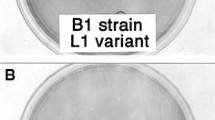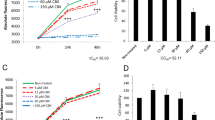Summary
Both monensin and cytochalasin D reduced the production of infectious cell associated virus and infectious extracellular virus with the latter clearly being the more sensitive. The difference in yields were even more clearly seen if the yield of virus particles was monitored instead of yield of infectious virus. Addition of 1 µg/ml cytochalasin D or 1 µm monensin to the growth medium of vaccinia virus-infected cells inhibited the appearance of extracellular enveloped vaccinia virus (EEV) in the growth medium without affecting the production of intracellular naked vaccinia virus (INV) particles. Although EEV was not released into the medium of cytochalasin D treated cells, EEV was, nevertheless, detectable in CsCl gradients of cell associated virus. Monensin treatment did not affect the synthesis of vaccinia glycoproteins but did significantly reduce the transport of these glycoproteins to the cell surface and also reduced the secretion of proteins. Monensin had the additional effect of causing the appearance of numerous large vacuoles in the cytoplasm. Vaccinia is normally wrapped by cytoplasmic membranes in preparation for release. The monensin induced conversion of cytoplasmic membranes to large vacuoles is presumably the basis for the block in virus wrapping and subsequent release. Cytochalasin D did not alter any of the steps in protein synthesis, transport or secretion. Electronmicroscopic studies confirmed the existence of EEV on the surface of infected cells treated with cytochalasin D. This drug which specifically affects cellular microfilament organisation thus imposes a block on the final release of EEV from the cell surface.
Similar content being viewed by others
References
Ichihashi, Y., Matsumoto, S., Dales, S.: Biogenesis of poxviruses: role of A-type inclusions and host cell membranes in virus dissemination. Virology46, 507–532 (1971).
Johnson, D. C., Schlesinger, M. J.: Vesicular stomatitis virus and Sindbis virus glycoprotein transport to the cell surface is inhibited by ionophores. Virology103, 407–425 (1980).
Kato, N., Eggers, H. J., Rolly, H.: Inhibition of release of vaccinia virus by N1-isonicotinoyl-N2-3-methyl-4-chlorobenzoylhydrazine. J. Exp. Med.129, 795–808 (1969).
Morgan, C.: Vaccinia virus reexamined: development and release. Virology73, 43–58 (1976).
Mousa, G. Y., Trevithick, J. R., Beckberger, J., Blain, D. G.: Cytochalasin D induces the capping of both leukemia viral proteins and actin in infected cells. Nature274, 808–809 (1978).
Payne, L.: Polypeptide composition of extracellular enveloped vaccinia virus. J. Virol.27, 28–37 (1978).
Payne, L. G.: Identification of the vaccinia hemagglutinin polypeptide from a cell system yielding large amounts of extracellular enveloped virus. J. Virol.31, 147–155 (1979).
Payne, L. G.: Significance of extracellular enveloped virus in thein vitro andin vivo dissemination of vaccinia. J. gen. Virol.50, 89–100 (1980).
Payne, L. G., Kristensson, K.: Mechanism of vaccinia virus release and its specific inhibition by N1-isonicotinoyl-N2-3-methyl-4-chlorobenzoylhydrazine. J. Virol.32, 614–622 (1979).
Payne, L. G., Kristensson, K.: The effect of glycosylation inhibitors on the release of enveloped vaccinia virus. J. Virol.41, 367–375 (1982).
Pressman, B. C.: Biological applications of ionophores. Anm. Rev. Biochem.45 501–530 (1976).
Tanenbaum, J., Tannenbaum, S. W., Godman, G. C.: The binding sites of cytochalasin D. I. Evidence that they may be peripheral proteins. J. Cell. Physiol.91, 225–238 (1977).
Tartakoff, A. M., Vassalli, P.: Plasma cell immunoglobulinsecretion. Arrest is accompained by alterations of the Golgi complex. J. Exp. Med.146, 1332–1345 (1977).
Author information
Authors and Affiliations
Additional information
With 4 Figures
Rights and permissions
About this article
Cite this article
Payne, L.G., Kristensson, K. The effect of cytochalasin D and monensin on enveloped vaccinia virus release. Archives of Virology 74, 11–20 (1982). https://doi.org/10.1007/BF01320778
Received:
Accepted:
Issue Date:
DOI: https://doi.org/10.1007/BF01320778




